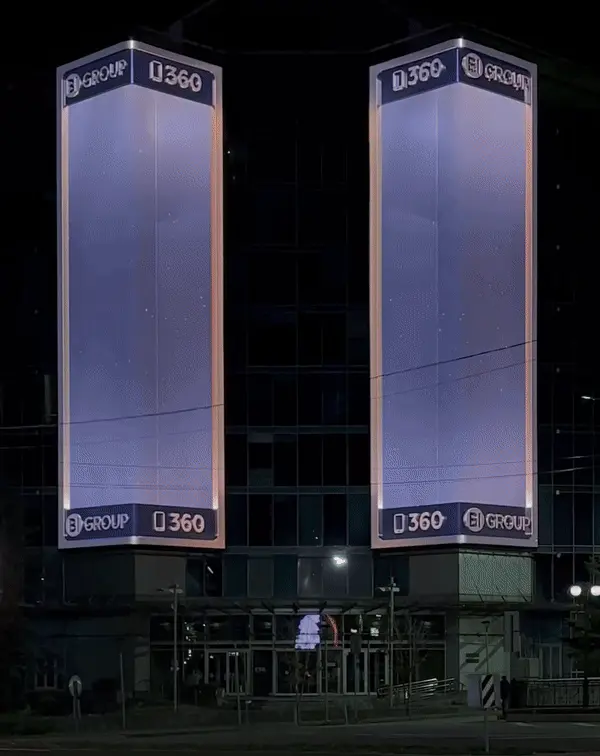Anamorphic 3D Billboards and LED Advertising: Technology, Examples, and Pricing
1. What Are Anamorphic 3D Billboards (Naked-Eye / Glasses-Free 3D) and Why They Work
Anamorphic 3D billboards — also known as naked-eye 3D displays and glasses-free 3D (glass 3D) — are one of the most powerful tools for brands in outdoor advertising. They draw crowds, go viral on social media, and turn your brand into a headline-worthy story.
Behind the “wow” factor of naked-eye 3D content lies a serious production process: CGI, tracking, precise screen calibration for glasses-free 3D, on-site testing, and dozens of hours of post-production.

2. How We Create Content for Anamorphic 3D Billboards — From Concept to Final Render
Before moving on to the technical scene setup, we start with the foundation — the idea and visual direction.
To ensure your 3D billboard delivers the maximum “wow factor” and goes viral, here are several proven techniques guaranteed to capture the attention of passersby:
The Room Effect
This is one of the most popular techniques in anamorphic 3D billboards. The LED screen is transformed into an architectural element of the building, creating the illusion of a confined space.
We build a photorealistic environment — walls, ceiling, floor, and lighting. The viewing angle and perspective are calculated so the illusion works only from the audience’s point of view. Inside this “room,” we place a product, character, or dynamic scene.

Breaking the Frame
One of the most striking techniques in anamorphic 3D billboards and LED advertising. The object literally “jumps” out of the screen boundaries, creating a full illusion of presence in real space.
The viewer experiences a “rule-breaking” moment — the familiar frame of the screen disappears, instantly drawing attention to the motion and scale. This technique works especially well for dynamic scenes, large-scale objects, and advertising campaigns that require a strong visual impact.


Interacting with the Environment
A technique that makes anamorphic 3D billboards look as realistic as possible. The scene is designed with the architecture of the building in mind, integrating seamlessly with the LED screen. This approach makes the illusion feel natural, convincing the viewer that the object truly exists in real space.
Such integration is especially effective in DOOH advertising, where it’s important to make digital content appear as part of the surrounding environment.


Scaling Effect
A technique perfectly suited for product presentations with a focus on fine details. The object appears small on the screen and gradually scales up, revealing its key features and textures.
The element of surprise captures the attention of passersby and boosts engagement, especially in anamorphic 3D billboards and LED advertising for brands that want to highlight the quality and uniqueness of their products.

Glass Illusion
A technique where the LED screen frame transforms into a glass showcase, revealing a dynamic scene behind it. To the viewer, it feels as if they are looking through a transparent window into the real world.
This effect is often used in anamorphic 3D billboards and DOOH advertising to create a sense of premium quality. It allows you to “sell” not only the product itself but also the atmosphere around it, enhancing the brand’s emotional appeal.


Destruction Effect
A spectacular technique in anamorphic 3D billboards and LED advertising where scene elements “break” the screen — smashing the frame, knocking out bricks, and scattering debris.
This effect instantly grabs the attention of passersby, as people naturally respond to unexpected actions and high-energy visuals. It’s perfect for brands aiming to highlight power, energy, and drive in their advertising campaigns.

3. How an Anamorphic 3D Illusion is Created — The Technical Foundation
An anamorphic 3D video is a visual trick based on an optical illusion. From one fixed viewing point, the object appears fully three-dimensional and seems to “pop out” beyond the LED screen.
To achieve this effect, the 3D scene is built not as a standard animation frame, but with the real parameters of the location in mind — including screen dimensions, viewing angle, and perspective. This approach allows for the creation of highly realistic and captivating DOOH advertising.

Key Stages of Technical Preparation
- Scanning the Screen and Location — capturing the exact LED screen dimensions (width, height, curvature depth), installation angle, and key viewing point.
- Creating a 3D Model of the Screen — with accurate proportions and resolution.
- Positioning the Camera — exactly at the viewer’s position to ensure the illusion works perfectly from that angle.
- Forced Perspective — intentionally distorting objects to match the chosen angle so they appear 3D and extend beyond the screen boundaries.
4. Anamorphic 3D Billboard Production Costs
At Coper, we create content for anamorphic 3D billboards and LED screens — from concept development and technical preparation to final rendering and on-site testing. We tailor every project to the specific screen, its dimensions, format, and marketing objectives.
We are ready to consult on your project, propose a creative solution, and provide a full production cycle for impactful DOOH advertising.
- Simple scene (1–2 objects, basic animation) — from $2,000 to $4,000
- Medium complexity (custom 3D model, visual effects, compositing) — from $4,000 to $5,000
- Complex projects (simulations, characters, advanced camera work) — from $5,000
5. Coper Case Studies
Examples of our work for brands such as KFC, Nivea, Hansa, and others can be found in the Case Studies section of our website.
Some visual examples in this article from other creators are used solely for clearer demonstration purposes.
Contact us to get a cost estimate for your anamorphic 3D billboard or LED advertising project.


